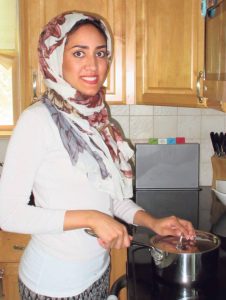I had just finished a plate of koshari, when Soha Sattar urged me to have more. It was so delicious that I was happy to have another helping. Later, “Please have more, it’s the Egyptian way,” she laughed. “There’s no such thing as no.”
Koshari is a hearty and inexpensive vegetarian dish of rice, lentils, pasta, chickpeas, tomato sauce and crispy fried onions that is popular throughout Egypt. The ingredients are layered with cooked rice on the bottom, lentils next, then pasta and chickpeas that have been marinated in vinegar and cumin, very crispy bits of onion and topped off with a swirl of tomato sauce to bring it all together. Bowls of all the ingredients are served with it so you can add whatever else you have a hankering for.

Koshari is thought of as a “people’s food,” said Sattar and is a popular street food that is also sold in restaurants and eaten at home. “Every family has their own way of preparing it,” she said. “There’ll be another Egyptian reading my recipe who will say, ‘that’s not right.’” She said that non-Egyptians will often make the dish without the pasta, perhaps put off by the combination of rice and pasta, or wanting to cut down on the carbs.
Sattar’s husband Adam Khader, also Egyptian, brought an innovation from his family to her koshari with the practice of adding vinegar and cumin to the chickpeas.
Sattar was brought up in Qatar where her parents had settled but still developed strong ties with their homeland of Egypt. Until she finished high school the family would return to Egypt every summer, staying in the apartment building owned by her grandfather, where other family members lived. “We would gather in our grandparent’s apartment for meals,” she said. She especially enjoyed the fish prepared Egyptian style. A whole fish, such as branzino, is encased in cracked wheat, cumin, allspice and garlic, and blackened over charcoal. Soha says this fish is served with a special rice that was browned with chopped onions and spices like cumin, cinnamon and all spice, with tahini drizzled over the rice. “For me it was never about the fish itself but the way all the flavors worked together,” she says.
BBQ is also popular in Egyptian cuisine, with the meat marinated in onion, salt and lemon and serve with tahini sauce. A typical breakfast is fava bean stew. Traditionally the beans are cooked for hours on low heat in a special pot, which tapers to a narrow neck, called an idra. The cooked beans are mashed and then flavored with cumin, olive oil, salt and lemon. This, too is a popular street food and eaten with pita bread.
Sattar and Khader met in Qatar, where he too was raised. They married in 2010 and came to the U.S. to study. Sattar has just finished the course work at Colombia Teacher’s College for a doctorate in mathematics and Khader is a surgery resident at Northwell. Although they enjoy living in Westbury, they don’t know where fate will take them and their two young children when Khader moves on to further specialization in his field.
If they have to leave Long Island, Sattar says she hopes it will be some place warm…perhaps as warm as Qatar.

Koshari
1 cup short grain white rice
1 cup brown lentils
1 cup elbow pasta
1 15-ounce can chickpeas
1 to 2 tbsp vinegar
2 medium onions
1 15-ounce can tomato sauce
2 cloves garlic, minced
1 tbsp cumin
Salt and pepper to taste
1. Separately cook the rice, lentils and pasta.
2. Saute garlic, add tomato sauce and season with salt and pepper (you can spice it up with chili powder or cayenne).
3. Mix the chickpeas with cumin and vinegar
4. Slice the onion into very thin strips, sprinkle with flour and deep fry in oil.
5. To assemble, mix the rice with lentils and spread in the bottom of a pan or plate; add a layer of pasta, then a layer of chickpeas and then the fried onions. Swirl the sauce on top. Serve with more of everything on the side.































